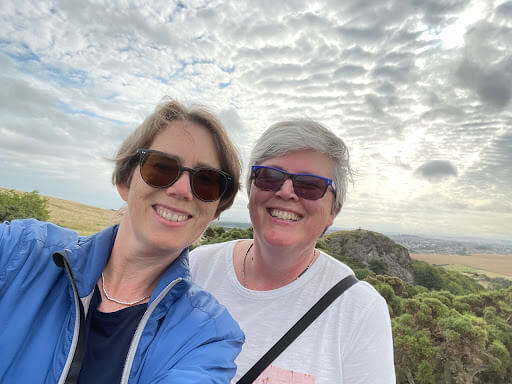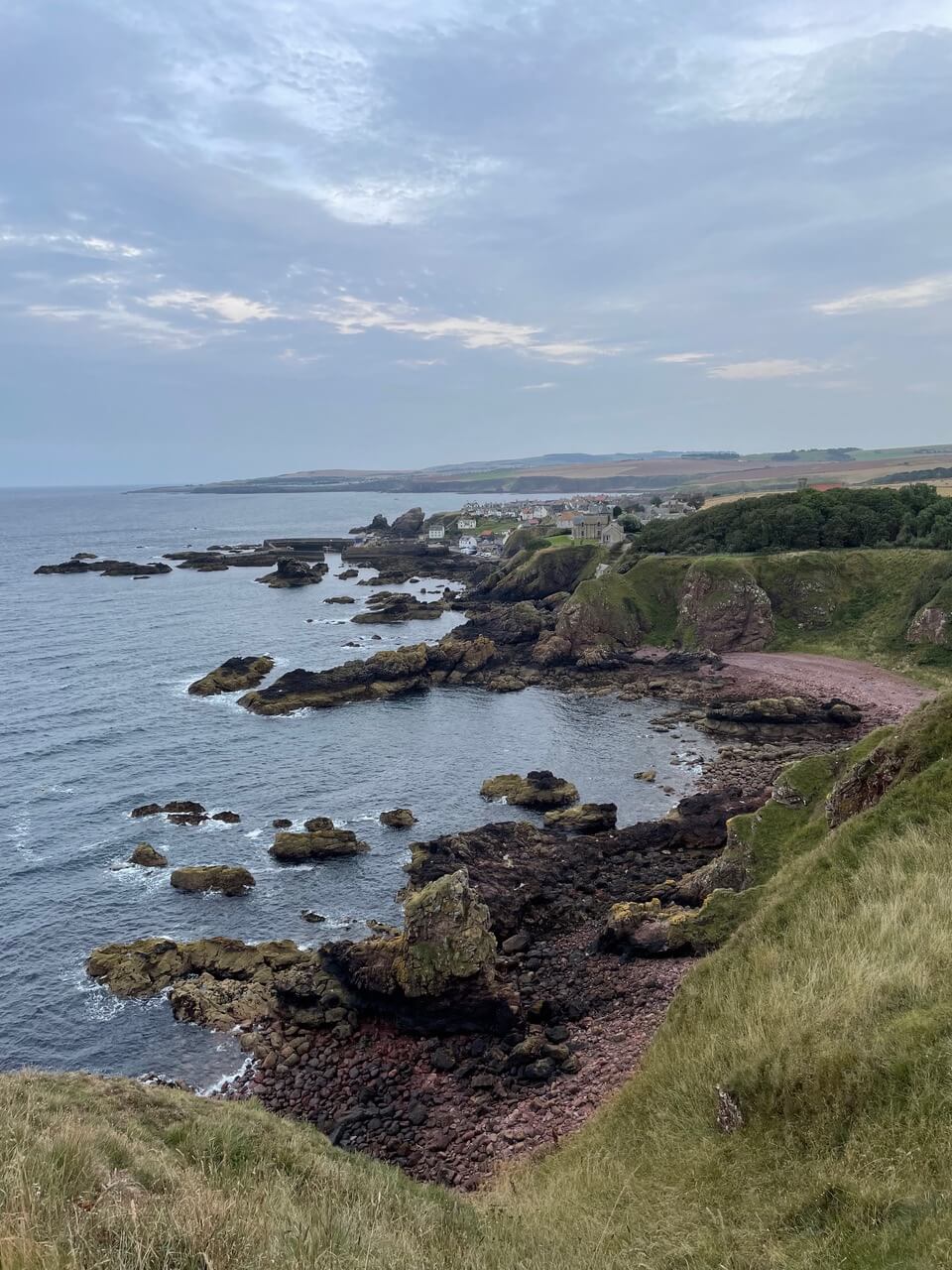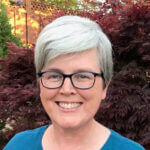I’m in Scotland this month visiting my family and working remotely. On Monday, on my drive to my village, I was thinking about this assignment and reflecting on the themes some of my colleagues chose for their statements of purpose—to contribute more than we take, tradition, and community. For me, it’s the sense of belonging and caring I feel when I’m connected to place, how unsettled I feel when I’m not, and how important it is for me to establish a place-based connection as I move around the world.
It’s clear that establishing that connection—that sense of belonging—is about my connection to the natural world rather than the built environment. This could be due to growing up in rural Scotland, but I think it’s more profound than that. It has more to do with a visceral connection to deep time—seeking some sense of permanence, a steadiness, in a human-built world that is impermanent and volatile. It’s essential I feel grounded as I make a contribution to our work and I feel that most keenly when I’m connected to place.

There’s no shortage of opportunity for connection when I’m in Scotland. For the first part of my drive on Monday, I took the coast road out of Edinburgh and drove alongside the Firth of Forth. The firth (estuary) was formed during the last glacial period. Once beyond the firth, the North Sea was my companion as I made my way to the Berwickshire countryside where I grew up. I’m not entirely sure when my village was established as a settlement, but I do know the church was built in the 12th century and that my family has lived there, and still does, since at least the 1300s. When I was young, my grandad used to drive me along the country roads and have me name landmarks en route. To this day, as I drive from my village to the nearby town of Berwick-upon-Tweed, I silently recite the place names—Edington Mill, Foulden, the Border (between Scotland and England), Cumberland Bower, Brow of the Hill, and Halidon Hill. The latter was the site of a battle in 1333, where the Scots lost to the English army in an attempt to gain political independence from England.
I’m aware when I’m in this place that my ancestors were too, and that leaves me feeling very content. On a recent walk with my sister, we walked along the loaning (lane) behind our village, and I knew my ancestors had walked the same path. We saw something they never saw though. In November 2021, Storm Arwen brought northerly winds gusting at over 70 mph to the region. The highest gust speed was 98 mph. The damaging winds snapped trees in half and uprooted mature trees that had provided shelter and shade for decades. It was a devastating scene. According to the Met Office (UK weather service), the storm was representative of a trend in more severe storms due to climate change. That beautiful scene, which generations of my family had experienced, was destroyed by one overnight storm.
I’ve now lived in California longer than I lived in Scotland. When I first moved to California in 1996, I struggled to establish this sense of place. I was attracted to the geography of the Bay Area, but it was more congested and polluted than anywhere I’d lived. When we bought our first home, we bought a small house on a large plot and I started to put down roots by creating a garden. We designed it using permaculture principles, the idea of “permanent agriculture” or lasting design. I learned so much about my new home from that small plot of land—the soil type, the curve of the land, where rain fell or didn’t, the types of plants that thrived there, etc. We chose to create an edible landscape and produced so much food we got to know our neighbors through sharing it. My harvest days were pretty popular at the office too. My journey to deeply understanding the value of place and caring for it led me to the work we’re doing at Ten Strands.
In 2012, I was lucky enough to meet Will Parish, Ten Strands’ founder. We met at a time when we were ready to embark on something new professionally, and together, with our amazing team, we’ve been able to co-create an organization that helps “galvanize and harmonize” the work of many organizations working at the intersection of education and the environment.

It’s deeply satisfying to support initiatives that serve to advance students’ connection to place. The strands of our work represent a coming together to identify and solve problems related to supporting students on their journey to deeply understanding the interdependence of natural systems and human social systems—essential and enduring understandings given the rapidly increasing impact of climate change.
The task ahead is daunting and can feel overwhelming. When it does, I think of Jane Goodall’s response at the Global Climate Action Summit in San Francisco in 2018, when someone asked her how she copes with the enormity of what’s in front of us. She said she just focuses on the single piece of the jigsaw puzzle she can influence and she trusts that others are doing the same. I find great solace in that idea and also hope and optimism that collectively much can be accomplished. I also think of ways I can spend less time in my head and more time in my heart so I can be fully present for this work. The easiest way for me to do that is to read and, increasingly, write poetry. In Scotland, we have a great tradition of poetry. Our poet laureates are called Makars, which makes me think of a maker—a roll up your sleeves and get the job done doer.
I’ll end by sharing a poem I wrote the last time I visited Scotland.
The Burn (stream) at Braid
A Magpie leaving her parliament led me to the burn at Braid.
She rattled off the names of the trees that provided shade
and kept everything cool that warm September morning.
Ash, Elm, and Oak from ancient times, and more recently Sycamore and Beach that have become naturalized and are now part of this woodland family.
I can feel the belonging in this place.
The satisfaction that the complex arrangements of roots beneath the surface provide the good, and necessary, grip of Scotland.
Century after century, the trunks, branches, and canopy have been buffeted around by the weather, yet they remain held and intact.
Even the flow of the burn feels sure as it rises in the Pentland Hills and makes its way north-east to enter the Firth of Forth at Portobello.
And from there into the roaring North Sea and the world’s Ocean.
Neither rocks, nor fallen branches, nor human constructions will keep it from making its way through the gorge cut by glacial meltwater to its final destination.
And what of me and this place?
I feel the same belonging. My roots run just as deep, my trunk, branches, and canopy are just as resilient.
I can stand beside, or preferably in, any trickling tributary of any river on this homeland and feel deeply connected to this place and, in turn, to the rest of the world.


5 Responses
I too was at that meeting in in 2018 – my real sense of place resides in the spit of land and estuaries, embracing the north atlantic known as cape cod- but my ancestors foot prints were made in the coal mines of wales and open lands of your favored grounds- with a sense of time in the stones and trees … but on the cape, it is the ancient horseshoe crab that stands watch of millions of year- not changing a whit to survive – its the osprey and gulls, the Kingfisher who refuels my tank- the herring struggling up the run to pilgrim lake… its wooden sail boats and old Maine canoes… so I work for a CA Assembly member, and we fight rodenticide and microplastics with laws as walls and scientists as our scribes and genetic soothsayers… so we live parallel and intersect on the dry click of keys and digital solitudes… maybe to meet , may we continue…
I’m loving reading these statements of purpose. Thanks, Karen, for sharing more about your homeland and deep connection to it, and for the poem! And it’s so nice to meet your sister.
Thanks for sharing your amazing journey, Karen.
Karen, your statement of purpose is a Magpie’s call and cry for seeing. Thank you for this singular view of a tiny part of your world and the need to use our own connections to places to inspire us to keep fighting against climate change.
What a beautiful reflection on the importance of place and being rooted to a landscape and its communities. Thank you for sharing this, Karen!